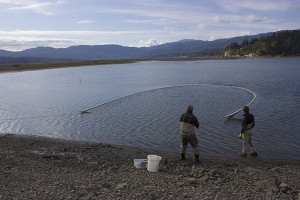Northwest Indian Fisheries Commission
Work is set to begin this summer to restore salmon habitat in Illabot Creek, a tributary to the Skagit River.
Once a winding, multi-channeled creek, Illabot was straightened and diked in 1970 when a bridge crossing was constructed on Rockport-Cascade Road. Straightening the creek degraded salmon habitat by creating a steeper gradient, reducing channel area and habitat complexity.
Illabot Creek is a highly productive tributary to the upper Skagit River, supporting chinook, chum, coho and pink salmon, native char and steelhead trout. Much of the watershed already has been protected or restored, but this half-mile reach on the historic alluvial fan remains heavily degraded.
The Skagit River System Cooperative (SRSC), the natural resources extension of the Swinomish and Sauk-Suiattle tribes, plans to restore Illabot Creek to its historic channel by removing dikes downstream of the road and excavating to encourage new channels to develop.
“Not only will the restoration improve channel complexity and instream habitat conditions, but it also will restore connectivity within the floodplain and increase the number and surface area of channels as Illabot Creek migrates over time,” said Devin Smith, senior restoration ecologist with SRSC.
Future restoration plans include installing two new bridges and removing dikes upstream of the road.




